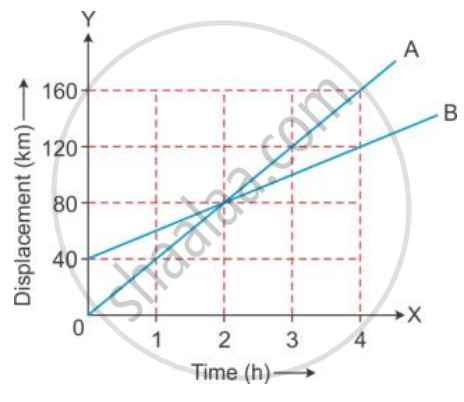Advertisements
Advertisements
Question
How can you find the following?
Displacement from velocity – time graph.
Solution
Displacement from velocity – time graph: Displacement covered by a body is equal to the area under velocity – time graph. When an object moves with a uniform velocity, the velocity – time graph is a straight line (PQ) parallel to the time axis.

Take any two points A and B on velocity – time graph.
From A and B, draw two perpendiculars AD and BC on the time axis such that
OD = t1 and OC = t2
Let OP = AD = BC = v = Velocity of the body.
Area under velocity – time graph = Area of rectangle ABCD
= AD × DC = v × (OC − OD) = v (t2 − t1)
= Displacement covered by the body
APPEARS IN
RELATED QUESTIONS
State whether distance is a scalar or a vector quantity.
The displacement of a moving object in a given interval of time is zero. Would the distance travelled by the object also be zero ? Give reason for your answer.
What can you say about the nature of motion of a body if its displacement-time graph is A curve.
The following table gives the displacement of a car at different instants of time.
| Time (s) | 0 | 1 | 2 | 3 | 4 |
| Displacement (m) | 0 | 5 | 10 | 15 | 20 |
- Draw the displacement-time sketch and find the average velocity of the car.
- What will be the displacement of the car at (i) 2.5 s and (ii) 4.5 s?
Figure ahead represents the displacement - time sketch of motion of two cars A and B . Find :
(i) the distance by which the car B was initially ahead of car A.
(ii) the velocities of car A and car B.
(iii) the time in which car A catches car B.
(iv) the distance from start when the car A will catch the car B.

A body is moving along a circular path of radius r. What will be the distance and displacement of the body when it completes:
Full revolution
Ashok starts from his house and travels 3 km to reach his school. On finding the school gates closed, he returns to his house. What is?
The distance traveled by Ashok.
An object is thrown vertically upwards. It rises upto a height H and then returns to its initial position. Calculate
The total distance traveled by the object
A particle moves along a circular path. How many times does it change its direction in two complete rounds?
The table below shows the distance travelled by two vehicles A and B during each second:
| Time (s) | 0 | 1 | 2 | 3 | 4 | 5 | 6 | 7 |
| Distance travelled by A (m) | 0 | 20 | 80 | 180 | 240 | 300 | 360 | 420 |
| Distance travelled by B (m) | 0 | 10 | 40 | 90 | 160 | 250 | 360 | 490 |
Give the value of the velocity at which they are meeting
